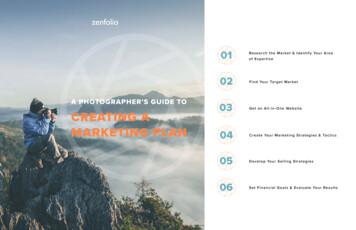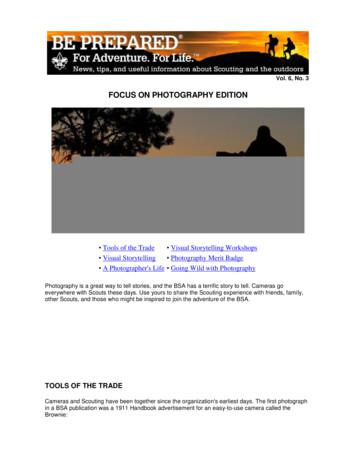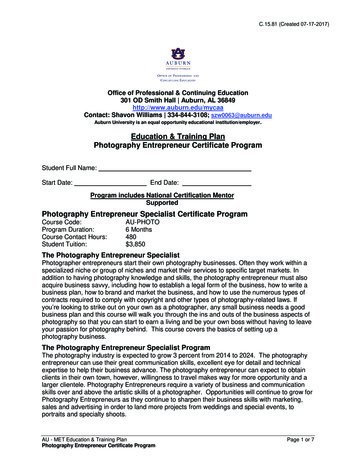Digital Photography I & II - Visual Arts
Thornton High School9351 North Washington Thornton, CO 80229Office: (720) 972-4800 Fax: (720) 972-4999http://www.thorntonh.adams12.orgSchool Year2017-2018OfficePhoneEmailAddress224Ext 4878Carol.I.Jennings@adams12.orgCourse NameCourseDescriptionUnit of StudyTeacherNameWebsiteBlogMs. Carol Jennings (2D/3D)Digital Photography I & II - Visual ArtsDigital Photography Course I & IIStudents will explore and learn various photography methods in the worldof digital photography ( DSL , Smart device camera, film, etc ). We will beworking to improve the knowledge in digital photography. We willaccomplish this through exercises, assignments, readings, study questions,class discussions, lectures, note-taking, films, research, essays, projects andoral presentations. To support students’ abilities to express themselves invisual arts, the course includes a structured approach to:o Explore various photo media techniques in the photography lab /technology roomo Photography composition, layout & Designo Students will be instructed on presentation techniques.o Understanding the process of critiquing and interpretingPhotographs through the lens of Historical perspectiveo Study various social and cultural functions of photography(Photojournalism)o The appreciation and evaluation of their own work and that ofothers.Throughout the course, students will:o Relate art to its cultural and historical contextso Explore art concepts & art elements & designo Develop confidence and expertise in the use of various mediao Share their work with an audience through displays and exhibitionsor presentationsIn this course, you will be required to use e-mail, participate in blogdiscussions, in class discussion, take quizzes, write artist reflections and visitart shows/exhibits outside of this class.Grade Level Expectations/Content StandardsElements andPrinciples A.HS;3 Invent and Discover to Create.GLE.1, 2. Demonstrate competency in traditional and new art media and applyappropriate and available technology for the expression of ideas. Assess and produceart with various materials and methods of photography.CAS.VA.HS;3 Invent and Discover to Create.GLE. 2. Assess and produce photographic artworks with various materials andmethodsPhotojournalismCAS.VA.HS;1 Observe and Learn to Comprehend.GLE.1-3. Visual art has inherent characteristics and expressive features. Historical andcultural context are found in visual art. Art and design have purpose and functionCAS.VA.HS;2 Envision and Critique to Reflect.GLE 1-3. Reflective strategies are used to understand the creative process.Interpretation is a means for understanding and evaluating works of art. A personalphilosophy of art is accomplished through use of sophisticated language and studioart processes. Interpretation is a means for understanding and evaluating works ofart.CAS.VA.HS;3 Invent and Discover to Create.GLE.1-3. Demonstrate competency in traditional and new art media, and applyappropriate and available technology for the expression of ideas. Assess and produceart with various materials and methods. Make judgments from visual messages.Approximate Time Spentor Percent of time SpentPractice all semesterTargeted Date ofAssessmentTBDPractice All SemesterTBD
Thornton High School9351 North Washington Thornton, CO 80229Office: (720) 972-4800 Fax: (720) 972-4999http://www.thorntonh.adams12.orgCritical Research/ History ofPhotographyCameraequipment /lighttechniquesDigital Portfolio/Website DesignArtist StatementPhotographyArt CritiqueCAS.VA.HS;1 Observe and Learn to Comprehend.GLE.1-3. Visual art has inherent characteristics and expressive features. Historical andcultural context are found in visual art. Art and design have purpose and functionCAS.VA.HS;2 Envision and Critique to Reflect.GLE 1-3. Reflective strategies are used to understand the creative process.Interpretation is a means for understanding and evaluating works of art. A personalphilosophy of art is accomplished through use of sophisticated language and studioart processes. Interpretation is a means for understanding and evaluating works ofart.CAS.VA.HS;4 Relate and Connect to TransferGLE.1-3. The work of art scholars impacts how art is viewed today. Communicationthrough advanced visual methods is a necessary skill in everyday life. Art is a lifelongendeavor.CAS.VA.HS;1 Observe and Learn to Comprehend.GLE.1-3. Visual art has inherent characteristics and expressive features. Historical andcultural context are found in visual art. Art and design have purpose and functionCAS.VA.HS;2 Envision and Critique to Reflect.GLE 1-3. Reflective strategies are used to understand the creative process.Interpretation is a means for understanding and evaluating works of art. A personalphilosophy of art is accomplished through use of sophisticated language and studioart processes. Interpretation is a means for understanding and evaluating works ofart.CAS.VA.HS;3 Invent and Discover to Create.GLE.1-3. Demonstrate competency in traditional and new art media, and applyappropriate and available technology for the expression of ideas. Assess and produceart with various materials and methods. Make judgments from visual messages.CAS.VA.HS;4 Relate and Connect to TransferGLE.1-3. The work of art scholars impacts how art is viewed today. Communicationthrough advanced visual methods is a necessary skill in everyday life. Art is a lifelongendeavor.CAS.VA.HS;3 Invent and Discover to Create.GLE.1-2. Demonstrate competency in traditional and new art media, and applyappropriate and available technology for the expression of ideas. Assess and produceart with various materials and methods.CAS.VA.HS;1 Observe and Learn to Comprehend.GLE 1. Visual art has inherent characteristics expressive features.CAS.VA.HS;2 Envision and Critique to Reflect.GLE.1-3. Demonstrate competency in traditional and new art media, and applyappropriate and available technology for the expression of ideas. Assess and produceart with various materials and methods. Make judgments from visual messages.CAS.VA.HS;4 Relate and Connect to TransferGLE.1-3. The work of art scholars impacts how art is viewed today. Communicationthrough advanced visual methods is a necessary skill in everyday life. Art is a lifelongendeavor.CAS.VA.HS;1 Observe and Learn to Comprehend.GLE.1-3. Visual art has inherent characteristics and expressive features. Historical andcultural context are found in visual art. Art and design have purpose and functionCAS.VA.HS;2 Envision and Critique to Reflect.GLE 1-3. Reflective strategies are used to understand the creative process.Interpretation is a means for understanding and evaluating works of art. A personalphilosophy of art is accomplished through use of sophisticated language and studioart processes. Interpretation is a means for understanding and evaluating works ofart.CAS.VA.HS;4 Relate and Connect to TransferGLE.1-3. The work of art scholars impacts how art is viewed today. Communicationthrough advanced visual methods is a necessary skill in everyday life. Art is a 0-69GradePercentages/WeightsSummativeAssessments & ProjectsFormative Assessments& Projects80%20%Practice all semesterTBDPractice all semesterTBDPractice all semesterTBDPractice all semesterTBDTests, Quizzes, Artist Statements, Personal Websites, Rubrics, FinishedProducts/Projects, Presentations, Sketchbook/Investigation WorkbookSketchbook/Investigation Workbook, Peer Evaluations, In-Process Critiques,Self-Evaluations, Worksheets, Class Participation*Weekly progress grades are posted athttps://ic.adams12.org/campus/portal/adams12.isp
Thornton High School9351 North Washington Thornton, CO 80229Office: (720) 972-4800 Fax: (720) 972-4999http://www.thorntonh.adams12.orgF59-50* Criteria and expectations are given for each assignment and may differ for each assignment. If students’ use their class time responsibly, turns in theirwork on time, and actively participates in class activities, success is guaranteed.General Expectations Grades are based upon the demonstration of proficiency on units associated with a standard given during each formative orsummative assessment. Formative grades in addition to summative unit assessments will be used to holistically determine yourgrade. Summative: 80% Summative measures of achievement are taken when unit master is expected. (i.e., unit tests, culmination of aproject, embedded assessments, etc.) Formative: 20% Formative assessments measure the scaffolding skills and/or content embedded in the unit. Formative assessmentsare taken frequently, after a student has practiced a skill or become familiar with content. Examples of formative assessmentsinclude but are not limited to exit tickets, paragraphs, oral check for understanding, warm-ups, stages in a large project, etc. Assessments will be graded based on teacher/district/state rubrics. On group projects, students will receive a grade for individual work and a group grade. Grades are based on achievement of Content Standards and Grade Level Expectations.IB Grade Descriptors:Grade 7 -- Excellent performanceDemonstrates in a highly consistent manner: excellent growth and a strong relationship between research and artistic production;thorough command of topics/concepts; highly developed understanding of sociocultural and historical perspectives in more than onecultural context; excellent critical analysis; excellent exploration of ideas, and meaningful and creative studio works (HL/SLA); excellenttechnical ability and effective setting and solving of artistic problems.Grade 6 -- Very good performanceDemonstrates in a very consistent manner: very good growth and a sound relationship between research and artistic production;thorough understanding of most topics/concepts; understanding of sociocultural and historical perspectives in more than one culturalcontext; very good critical analysis; very good exploration of ideas, and meaningful and creative studio works (HL/SLA); very goodtechnical ability and setting and solving of artistic problems.Grade 5 Good performanceDemonstrates in a consistent manner: good growth and a good relationship between research and artistic production; generally soundunderstanding of most topics/concepts; understanding of sociocultural and historical perspectives in more than one cultural context;good critical analysis; good exploration of ideas, and mostly meaningful and creative studio works (HL/SLA); good technical ability andsetting and solving of artistic problems.Grade 4 -- Satisfactory performanceDemonstrates in a fairly consistent manner: satisfactory growth and an adequate relationship between research and artistic production;satisfactory understanding of most topics/concepts; adequate understanding of sociocultural and historical perspectives in more thanone cultural context; satisfactory critical analysis; satisfactory exploration of ideas, and some meaningful studio works (HL/SLA);satisfactory technical ability and solving of basic and routine formal and technical problems.Grade 3 -- Mediocre performanceDemonstrates: mediocre growth and a partial relationship between research and artistic production; mediocre understanding of sometopics/concepts; partial understanding of sociocultural and historical perspectives in more than one cultural context; limited criticalanalysis; some mediocre exploration of ideas, and the limited development of a few meaningful studio works (HL/SLA); mediocretechnical ability and solving of some basic and routine formal and technical problems.Grade 2 -- Poor performanceDemonstrates: poor growth and a limited relationship between research and artistic production; weak understanding oftopics/concepts; poor understanding of sociocultural and historical perspectives in one or sometimes more cultural contexts; littlecapacity for critical analysis; poor exploration of ideas and the limited development of studio works (HL/SLA); poor technical ability andsolving of a few basic or routine formal and technical problems.Grade 1 -- Very poor performanceDemonstrates: very poor growth and a very limited relationship, if any, between research and artistic production; very weakunderstanding of topics/concepts; very poor understanding of sociocultural and historical perspectives in one or sometimes morecultural contexts; very little capacity for critical analysis, if any; very poor exploration of ideas in studio works (HL/SLA); very poortechnical ability and very occasional solving of basic or routine formal and technical problems.
Thornton High School9351 North Washington Thornton, CO 80229Office: (720) 972-4800 Fax: (720) 972-4999http://www.thorntonh.adams12.orgClass ExpectationsAttendance: Please refer to the school attendance policy. For each excused absence day, students will get 1 additional workday on aproject. Make up work time on the project must take place outside of regular class timeParticipation/Studio Time: Each day is worth 20 points in studio work. Students will not gain some/all/any of these points if they areabsent, late or choose not to partake in their studio work. Students are able to regain points if they need/want to by making up the timeon an off hour, after school or lunch. The time must be prearranged and convenient for the teacher, since it would be outside ofprescribed class time. Sometimes students leave the classroom to take photographs. Parents should be aware that during studio time,students may not be supervised by a teacher. Students are required to return to class at the end of studio time to check in with theteacher.School Equipment:At any point during the semester, students may be loaned and or using school equipment including but not limited to: cameras, tripods,lighting equipment, card readers, flash drives, scanners, computers, computer mice & keyboards, and other miscellaneous supplies. It isthe student’s responsibility to use school equipment in a safe manner. If equipment is broken, damaged, lost or stolen, it is theresponsibility of the student or family to pay for any replacements. Large items that are checked out to be borrowed overnight must besigned out in the teacher’s equipment logbook.Sketchbooks/Investigation Workbook:As part of the IB in the visual arts program, Investigation Workbooks/Sketchbooks are a required part of the IB curriculum.Sketchbooks/Investigation Workbook are used for students to brainstorm, make preliminary sketches, and explore options in thecreative process. Depending on the class, students are expected to work ten minutes (Warm-up) in their sketchbooks at the beginningof the class. The warm-up assignments are usually open to interpretation and are graded on use of time and completion of the warm-upassignment.Movies, YouTube, Shows, Clips:Throughout the course, instructional and animated movies or clips may be shown for inspiration and/or informational purposes.Movies will always be rated PG-13, PG, or G, anything else not rated will be appropriate for age level and content.Art Fee:In order to offer a variety of materials and to help pay for consumable supplies such as film materials, photographic paper, etc., we askthat students in Thornton High School art classes pay a 25.00 materials fee per semester. If this is a hardship in anyway please let Ms.Jennings know.Student Expectations1. Students are expected to be on time and prepared when class starts.2. Students are responsible for cleaning their work area and taking care of shared materials in the art room. Clean up and care formaterials and the room is part of the participation grade for each project.3. Students are expected to respect themselves, each other, and the materials.4. No food is allowed in the classroom.5. Students are expected to follow safety rules for tools and materials used in the classroom.6. Electronic devices may not be used at Thornton High School.7. Students are expected to have a good attitude when entering the classroom, try new things, and give their best effort on eachassignment.8. Plagiarism (using someone else’s work as your own) or cheating of any sort will result in a loss of credit for the entire assignment.This includes copying and pasting materials off the Internet into word processing programs, printing documents off the Internet andhanding them in as your own, photocopying, or copying words directly out of print sources without proper citation. There is NOreason why two assignments should look identical. If you are working with a classmate, your writing should still be individual.During tests, make sure to keep your eyes on your own paper. If I witness you looking at another student’s exam, I will give you onewarning; if the behavior persists, you will receive a “0” on that exam.
Thornton High School9351 North Washington Thornton, CO 80229Office: (720) 972-4800 Fax: (720) 972-4999http://www.thorntonh.adams12.orgCut off and Return PleaseI agree to abide by all rules for visual art class. I understand that if equipment is broken, damaged, or lost it is my responsibility to pay forany replacements. I understand that this contract must be signed by my parents and me in order to use materials and equipment. Bysigning my name and having my sign their name on this document indicates such person's approval of the information contained in thecontract.Student name Date:Parent name Date:Phone: Email:This contract must be returned by the 2nd week of class.
o Photography composition, layout & Design o Students will be instructed on presentation techniques. o Understanding the process of critiquing and interpreting Photographs through the lens of Historical perspective o Study various social and cultural functions of photography (Photojournalism)
Texts of Wow Rosh Hashana II 5780 - Congregation Shearith Israel, Atlanta Georgia Wow ׳ג ׳א:׳א תישארב (א) ׃ץרֶָֽאָּהָּ תאֵֵ֥וְּ םִימִַׁ֖שַָּה תאֵֵ֥ םיקִִ֑לֹאֱ ארָָּ֣ Îָּ תישִִׁ֖ארֵ Îְּ(ב) חַורְָּ֣ו ם
Photography 2. Portrait 3. Boudoir Photography 4. Wedding Photography 5. Newborn Photography 6. Landscape Photography 7. Photojournalism 8. Street Photography 9. Food Photography 10. Candid Photography SEARCH WORDS 10 TOP PHOTOGRAPHY WEB
1. Sony World Photography Awards 2. Fine Art Photography Awards 3. National Geographic Photography Competitions 4. Monochrome Photography Awards 5. International Photography Grant 6. Neutral Density Photography Awards 7. Nikon International Small World Photo Contest 8. ZEISS Photography Award 9. Chromatic Color Photography Awards 10. iPhone .
Smartphone Camera o Parts o Exposure o Focus o In Camera Editing o Export/download/share -photography school.com How Using Your Smartphone Camera Can Help Improve Your Photography https://digital-photography-school.com - 8 Ways to Use Your Smartphone for Photography Lynda.com - IOS 10 iPhone Photography and iPad essential training
FOCUS ON PHOTOGRAPHY EDITION Tools of the Trade Visual Storytelling Workshops Visual Storytelling Photography Merit Badge A Photographer's Life Going Wild with Photography Photography is a great way to tell stories, and the BSA has a terrific sto
Explain how a professional photography can brand a photography business endeavor and how effective branding can help the photography business Explain the different components of a marketing plan for a photography business Explain common ways that a professional photographer can use social media to advance a photography business .
Photography II Course: Photography II Course Description: Photography II provides the advanced photography student with practical knowledge and highly advanced skills for a comprehensive career in photography. Students will explore advanced lighting and editing techniques and the commercial distribution of photographic works.
Explain how a professional photography can brand a photography business endeavor and how effective branding can help the photography business Explain the different components of a marketing plan for a photography business Explain common ways that a professional photographer can use social media to advance a photography business .























